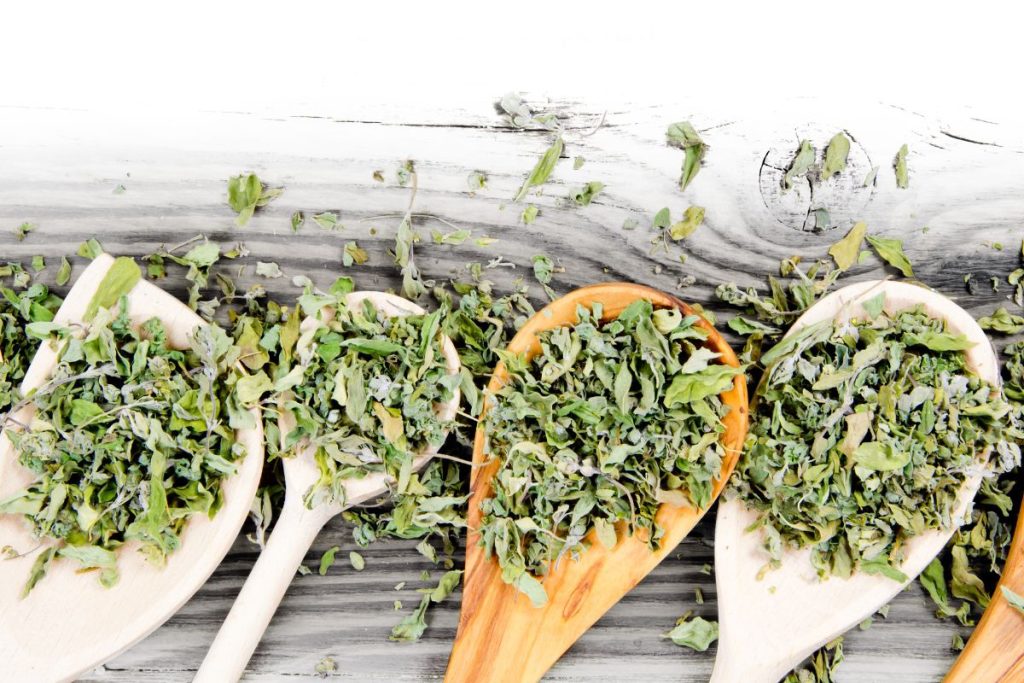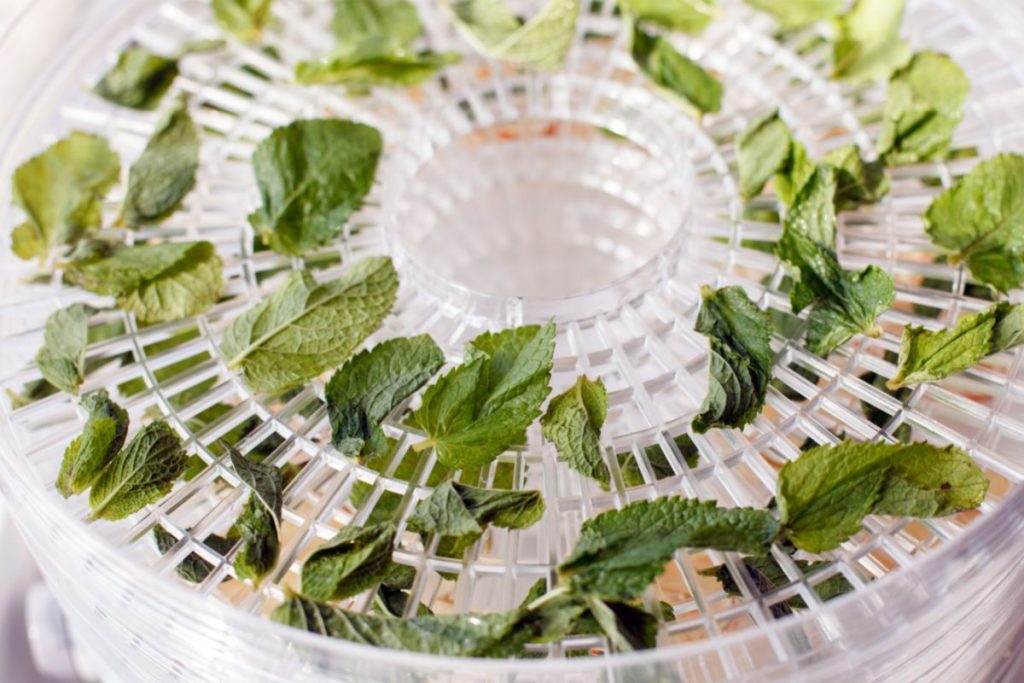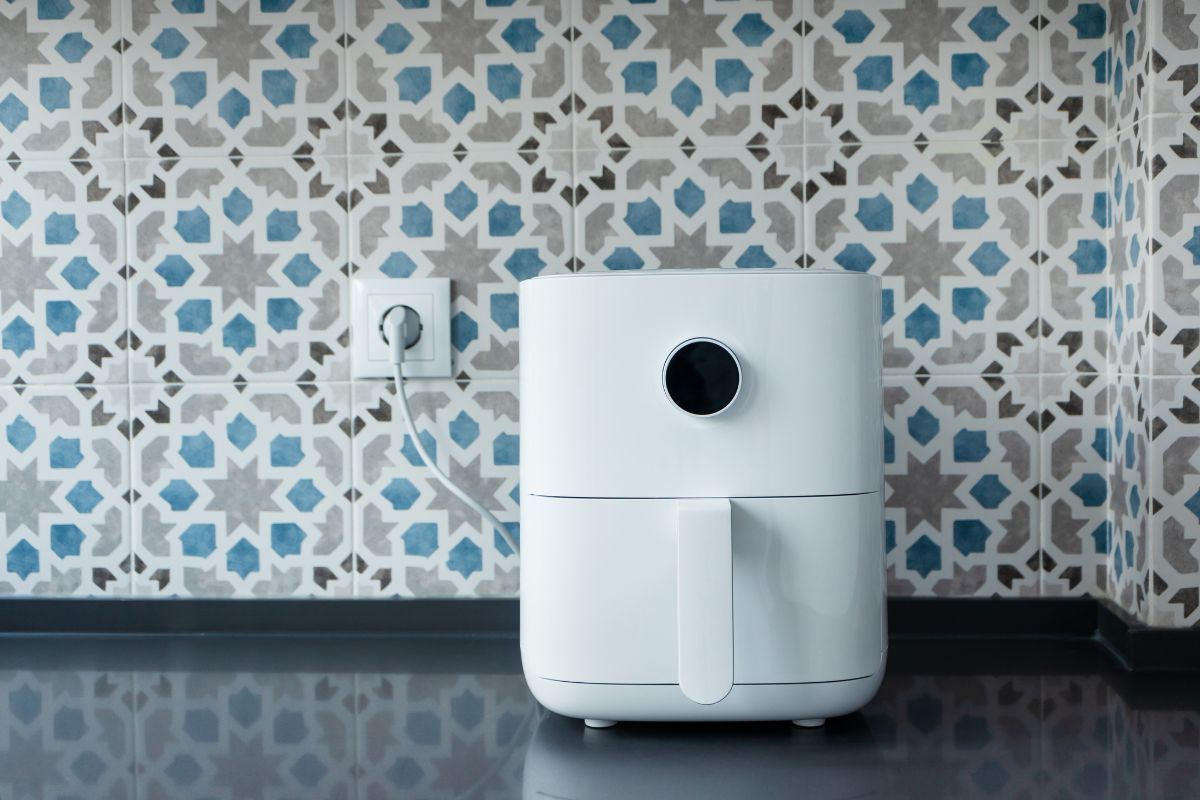When drying herbs in an air fryer, place rinsed fresh herbs in the fryer basket and dry them for 1-3 hours using the dehydrator setting or the lowest temperature setting.
Table of Contents
How to Dehydrate Herbs in an Air Fryer
Dehydrating herbs in an air fryer is quick and simple:
- Prepare fresh herbs by removing thick stems, buds, or discolored leaves. Wash the herbs in cool running water to remove dirt, pesticides, and insects. Pat them dry using paper towels or use a salad spinner.
- Preheat the air fryer for 5 minutes with the dehydrator setting. If your device lacks a built-in setting for dehydrating, preheat it on the lowest temperature setting.
- Spread the cleaned herbs in a uniform single layer inside the air fryer basket.
- Cover the basket with a wire rack to keep the herbs in place during dehydration. Alternatively, tie the sprigs of herbs with twine to secure them.
- Load the basket into the air fryer and dehydrate the herbs for 1-3 hours. The drying time will depend on the types of herbs and the air fryer model.
- Monitor the drying process and check on the herbs every 30 minutes.
- Check for doneness after the first hour. Take out a few sprigs, cool them to room temperature, and crumble them in your palms.
- If they are crumbly and show no signs of moisture content, take the rest of the herbs out and cool them to room temperature. Keep dehydrating if the herbs aren’t dry yet.
- Place all the fully dried herbs in clean airtight containers and store them in a cool, dark, dry place.

Tips for Dehydrating Herbs in an Air Fryer to Preserve Quality
Herbs are delicate plants, and exposure to too much heat can destroy them. Below are some handy tips to ensure your air-fried herbs retain their flavor and color:
- Add a desiccant packet if you open dehydrated herb containers often or live in a humid area.
- Clean the air fryer basket after each use.
- Cover the loaded basket with a wire rack to dry faster and prevent the herbs from scattering.
- Dehydrate different types of herbs separately to avoid flavor contamination.
- Dehydrate herbs in small batches to avoid uneven drying.
- Store dried herbs whole rather than crumbled to preserve flavor.
- Use the lowest temperature setting to dry herbs.
What are the Benefits of Drying Herbs in an Air Fryer?
Air frying herbs provides the following benefits:
- Air frying saves time as it is faster than other drying methods.
- Home-dried herbs taste better than their store-bought counterparts.
- It’s cheaper than other methods like oven drying since an air fryer uses less energy.
- It minimizes waste as herbs can be stored safely for future use.
Can you Use an Air Fryer as a Food Dehydrator?
You can use an air fryer as a food dehydrator to dehydrate many foods, including herbs, fruits, fruit leathers, vegetables, and meats.
Below are some herbs you can harvest from your herb garden and dry safely in an air fryer:
- Basil
- Celery leaves
- Chives
- Cilantro
- Oregano
- Tarragon
What is the Best Method for Drying Herbs?
The best method for drying herbs in large volumes is using a food dehydrator, while air-drying is the easiest and best for retaining flavor and color.
Food dehydrators significantly reduce the risk of molding associated with air-drying herbs. Since dehydrators are large and have multiple trays, they dry more herbs across a larger surface area and work at the ideal low-temperature range of 95°F-115°F. This also eliminates the need to dry herbs in bunches, as is often necessary with air-drying.

What Are Some Other Methods of Drying Herbs?
Besides air-frying, other methods for drying herbs include:
Air-drying
Air-drying involves hanging sprigs of fresh herbs upside down inside a paper bag indoors. It’s the easiest and cheapest method, but it takes 3 to 7 days to fully dry herbs. Try it with low-moisture herbs like oregano, dill, rosemary, and marjoram for the best results.
Food Dehydrator
A dehydrator dries herbs at 95°F-115°F over a period of several hours. It’s ideal for high-moisture herbs like chives, mint, and basil. The drying time depends on the type of herb, but more herbs can be dried simultaneously on different trays.
Oven-drying
Herbs are placed on a lined baking sheet and dried at the lowest oven temperature for several hours. It’s faster at drying herbs than a food dehydrator since most ovens have the lowest temperature between 125°F and 175°F.
However, the risk of burning and nutritional loss is higher. This method is trickier with conventional ovens. One simple hack is to leave the oven door slightly ajar to enhance aeration and moisture removal.
Sun-drying
Similar to air-drying, sun-drying uses the heat of the sun along with the air to dry herbs. The herbs are placed on a cheesecloth-covered screen or hung in bundles upside down and dried directly in the sun for several days to a week. The total time depends on the type of herb, humidity, and solar temperature.
High humidity levels and bringing them indoors each night pose challenges. The ideal minimum temperature for sun-drying herbs is 86 degrees Fahrenheit. Humidity levels should be below 60%.

What is the Shelf Life of Herbs Dried in an Air Fryer?
The shelf life of dried herbs is 6 months when stored in airtight containers such as Mason jars and stored in a cool, dry area. Dried herbs can have a longer shelf life of up to 12 months when placed in vacuum-seal bags or Myler bags and stored in the freezer.

